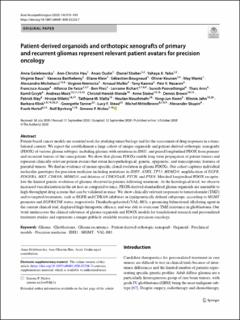Patient-derived organoids and orthotopic xenografts of primary and recurrent gliomas represent relevant patient avatars for precision oncology
| dc.contributor.author | Golebiewska, Anna | |
| dc.contributor.author | Hau, Ann-Christin | |
| dc.contributor.author | Oudin, Anaïs | |
| dc.contributor.author | Stieber, Daniel | |
| dc.contributor.author | Yabo, Yahaya A. | |
| dc.contributor.author | Baus, Virginie | |
| dc.contributor.author | Barthelemy, Vanessa | |
| dc.contributor.author | Klein, Eliane | |
| dc.contributor.author | Bougnaud, Sébastien | |
| dc.contributor.author | Keunen, Olivier | |
| dc.contributor.author | Wantz, May | |
| dc.contributor.author | Michelucci, Alessandro | |
| dc.contributor.author | Neirinckx, Virginie | |
| dc.contributor.author | Muller, Arnaud | |
| dc.contributor.author | Kaoma, Tony | |
| dc.contributor.author | Nazarov, Petr V. | |
| dc.contributor.author | Azuaje, Francisco | |
| dc.contributor.author | De Falco, Alfonso | |
| dc.contributor.author | Flies, Ben | |
| dc.contributor.author | Richart, Lorraine | |
| dc.contributor.author | Poovathingal, Suresh K | |
| dc.contributor.author | Arns, Thais | |
| dc.contributor.author | Grzyb, Kamil | |
| dc.contributor.author | Mock, Andreas | |
| dc.contributor.author | Herold-Mende, Christel | |
| dc.contributor.author | Steino, Anne | |
| dc.contributor.author | Brown, Dennis | |
| dc.contributor.author | May, Patrick | |
| dc.contributor.author | Miletic, Hrvoje | |
| dc.contributor.author | Malta, Tathiane M. | |
| dc.contributor.author | Noushmehr, Houtan | |
| dc.contributor.author | Kwon, Yong-Jun | |
| dc.contributor.author | Jahn, Winnie | |
| dc.contributor.author | Klink, Barbara | |
| dc.contributor.author | Tanner, Georgette | |
| dc.contributor.author | Stead, Lucy F. | |
| dc.contributor.author | Mittelbronn, Michel | |
| dc.contributor.author | Skupin, Alexander | |
| dc.contributor.author | Hertel, Frank | |
| dc.contributor.author | Bjerkvig, Rolf | |
| dc.contributor.author | Niclou, Simone Pierrette | |
| dc.date.accessioned | 2021-04-30T11:25:49Z | |
| dc.date.available | 2021-04-30T11:25:49Z | |
| dc.date.created | 2020-10-20T11:12:47Z | |
| dc.date.issued | 2020 | |
| dc.Published | Acta Neuropathologica. 2020, 1-31. | |
| dc.identifier.issn | 0001-6322 | |
| dc.identifier.uri | https://hdl.handle.net/11250/2740584 | |
| dc.description.abstract | Patient-based cancer models are essential tools for studying tumor biology and for the assessment of drug responses in a translational context. We report the establishment a large cohort of unique organoids and patient-derived orthotopic xenografts (PDOX) of various glioma subtypes, including gliomas with mutations in IDH1, and paired longitudinal PDOX from primary and recurrent tumors of the same patient. We show that glioma PDOXs enable long-term propagation of patient tumors and represent clinically relevant patient avatars that retain histopathological, genetic, epigenetic, and transcriptomic features of parental tumors. We find no evidence of mouse-specific clonal evolution in glioma PDOXs. Our cohort captures individual molecular genotypes for precision medicine including mutations in IDH1, ATRX, TP53, MDM2/4, amplification of EGFR, PDGFRA, MET, CDK4/6, MDM2/4, and deletion of CDKN2A/B, PTCH, and PTEN. Matched longitudinal PDOX recapitulate the limited genetic evolution of gliomas observed in patients following treatment. At the histological level, we observe increased vascularization in the rat host as compared to mice. PDOX-derived standardized glioma organoids are amenable to high-throughput drug screens that can be validated in mice. We show clinically relevant responses to temozolomide (TMZ) and to targeted treatments, such as EGFR and CDK4/6 inhibitors in (epi)genetically defined subgroups, according to MGMT promoter and EGFR/CDK status, respectively. Dianhydrogalactitol (VAL-083), a promising bifunctional alkylating agent in the current clinical trial, displayed high therapeutic efficacy, and was able to overcome TMZ resistance in glioblastoma. Our work underscores the clinical relevance of glioma organoids and PDOX models for translational research and personalized treatment studies and represents a unique publicly available resource for precision oncology. | en_US |
| dc.language.iso | eng | en_US |
| dc.publisher | Springer | en_US |
| dc.rights | Navngivelse 4.0 Internasjonal | * |
| dc.rights.uri | http://creativecommons.org/licenses/by/4.0/deed.no | * |
| dc.title | Patient-derived organoids and orthotopic xenografts of primary and recurrent gliomas represent relevant patient avatars for precision oncology | en_US |
| dc.type | Journal article | en_US |
| dc.type | Peer reviewed | en_US |
| dc.description.version | publishedVersion | en_US |
| dc.rights.holder | Copyright 2020 The Author | en_US |
| cristin.ispublished | true | |
| cristin.fulltext | original | |
| cristin.qualitycode | 1 | |
| dc.identifier.doi | 10.1007/s00401-020-02226-7 | |
| dc.identifier.cristin | 1840803 | |
| dc.source.journal | Acta Neuropathologica | en_US |
| dc.source.pagenumber | 919–949 | en_US |
| dc.identifier.citation | Acta Neuropathologica. 2020, 140, 919–949 | en_US |
| dc.source.volume | 140 | en_US |
Tilhørende fil(er)
Denne innførselen finnes i følgende samling(er)
-
Department of Biomedicine [708]
-
Registrations from Cristin [9531]

